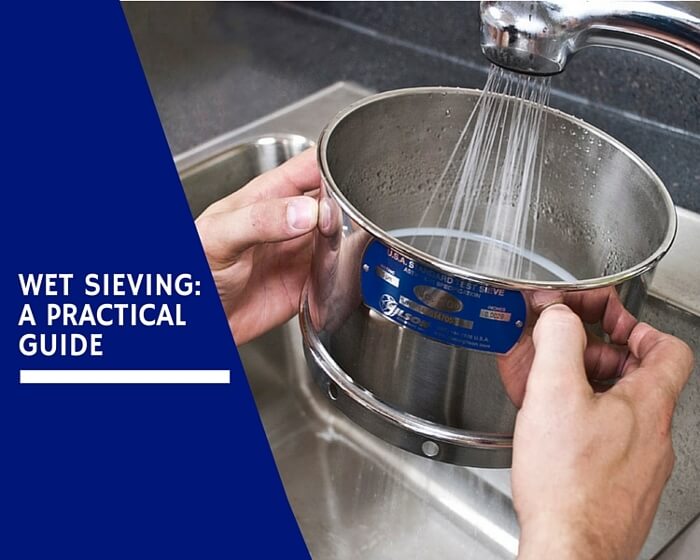
What do you do when you can’t perform a sieve analysis on a difficult, dry material? Wet sieving! While we recommend test sieving on dry materials whenever possible, sometimes you just can’t obtain reproducible results. If dry sieving can’t produce an acceptable degree of separation between the individual fractions, it’s time to try wet sieving. This blog post covers the importance of wet sieving when it is best used, and the various procedures you can use.
What is Wet Sieving?
Wet sieving is a procedure used to evaluate particle size distribution or gradation of a granular material. It’s also used to prepare a granular material for particle size analysis by removing fines that may impede the separation process.
When Should it Be Used?
Wet sieving can be used to remove fines of materials that may be difficult to sieve, prior to drying and testing a sample normally. The wet sieving procedure applies to solids with the following properties:
- Practically insoluble in water
- Not affected by water; for example, solids that expand when wet would not work
- Remain unchanged by heat up to 110°C
Materials and Applications:
Wet sieving is an ideal sample preparation process for specimens with a high fraction of granular materials and enough fines content present to make sieving difficult. The fines can stick together in clumps, preventing an accurate assessment by sieving. Wet sieving is also useful for direct particle sizing of problem materials including:
- Soils and mineral aggregates with high fine contents
- Materials that are fragile but not soluble, such as coal or other minerals
- Lightweight powders
- Sludge and glazes
- Kaolin and fillers
- Abrasives
- Micro granulations
How Do Testing Procedures Work?
Wet sieving is usually performed with one of two purposes in mind. Either the operation is performed to determine a fraction retained on a sieve or sieves, or it is a method of sample preparation that allows a later particle size analysis to be performed more easily or accurately. The procedures are often similar, but the one you choose should be based on your end goal.
Particle Size Analysis Method will have the goal in mind of recovering material that is left on each sieve after washing, then drying and weighing it to calculate the fraction of the whole sample it represents. The introduction of water and agitation can be performed manually by the operator on a single sieve, or by using distribution or spray fixtures at the top of a stack of sieves secured in a sieve shaker. Agitation is provided via mechanical shaker action, and wastewater is routed away using a special bottom pan fitted with a drain and tubing.
Although the use of deep frame Wet-Wash sieves is typical, conventional ASTM or ISO Test Sieves can also be used and are often fitted with Sieve Seal Gaskets to control leakage. Procedures are similar to conventional dry sieving, just messier. Use caution to prevent material loss when rinsing the individual fractions into containers for drying and subsequent weighing. Dedicated wet sieving equipment is available, some with self-contained vibration and vacuum systems, as well as wastewater recovery and recycling.
Wet-Wash Preparation Method involves agitating the sample as it is sprayed with water or while it is in a water suspension. The agitation is often done by hand using a Wet Wash Sieve underwater running from a faucet or dispersed through a spray fixture. Mesh sizes for these sieves are selected based on application requirements for particle sizes to retain. #200 (75µm) and #325 (45µm) are examples of popular opening sizes and optional backing cloth reinforces the mesh for longer service life.
A variation of this method is to place the entire sample in a pan, cover with water, then agitate by hand. The wastewater is decanted over a wet wash sieve and more water is added to the pan, continuing the process until the wastewater is relatively clear. The Aggregate Washer device mechanizes this process, saving time and increasing repeatability. Runoff can be filtered with a wet-wash or standard sieve positioned near a drain or fitted with a drain pan.
An Elutriation Sieve is a hollow plastic cylinder with large ports or windows cut in the sides and covered with stainless steel mesh. A sample is placed in the cylinder and water and compressed air are introduced through tubes to gently agitate the sample and wash away fines.
For rough separations or sample preparation, a Wet/Dry Sieve Vibrator has a simple frame with a vibrator attached that can hold one or two sieves over a bucket while being washed. When washing is complete, the total sample remaining is washed into a pan and placed into a 110°F oven for drying to a constant weight. Once dry, the process continues as a simple dry sieving test.
Helpful Tips and Tricks
- Determine total dry sample weight before beginning the process because you’ll need this weight for the final calculation
Soak the sample if time allows making the process easier - Add Sodium Hexametaphosphate or an anti-flocculent such as Calgon to the soaking solution to break down clumps and disperse particles
- Use nozzles or sprayers to disperse water and evenly wet the sample during sieving or agitation
- Use gentle, controlled water pressure to prevent accidental sample loss
It’s important to be aware that any wet sieving method has the potential for sample loss during the process. Some material may be washed away during agitation or decanting or may be forced into crevices of the sieve and become trapped. The percentage loss is very small and the accuracy and efficiency of wet sieving compared to dry sieving is worth the process if necessary for your application.
















